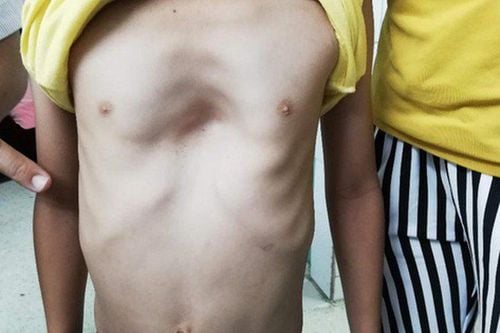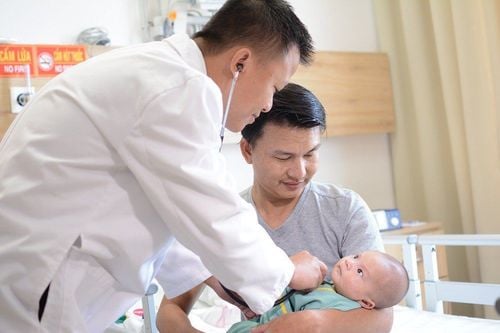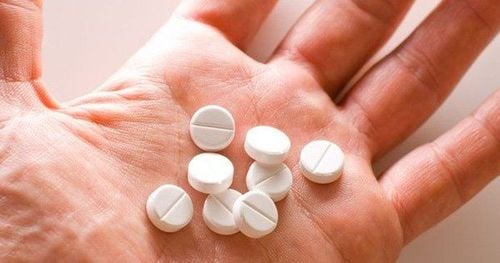This is an automatically translated article.
About 1 in 300 babies are born with sternal depression and about 10-15% of them have scoliosis and some other genetic diseases. Sternal depression in newborns can be detected quite early in the baby's life, but it does not always cause severe symptoms and must be treated.
1. Overview of breastbone depression in children Sternal depression, also known as funnel chest - is a birth defect in which the ribs and sternum develop abnormally and sink into the ribcage.
The disease is often recognized soon after birth, with a higher incidence of breastbone depression in male infants than in female infants. It can get worse as the child gets older and enters puberty. With mild breastbone depression, you may only notice a small depression in your chest. However, if it is more severe, the area around the sternum can appear to be several centimeters dented. Very severe cases of sternal depression can compress the lungs and heart, posing serious health risks.
It is little known that, as the patient ages, this anomaly can also lead to severe signs and symptoms, some leading to significant physical impairment, but few The report addresses this issue.
2. Causes of Sternal Concave in Children Until now, the exact cause and mechanism of Sternal depression in children are not known. However, it can be hereditary. In some cases, sternal depression in children is found in children in the same family. And children with sternal depression often have a number of other genetic diseases, such as:
Marfan syndrome: a connective tissue disorder of the body Polish syndrome: a rare birth defect A condition in which the muscles on one side of the body are underdeveloped or underdeveloped, especially the pectoralis major. Noonan syndrome (rare genetic disease of connective tissue characterized by brittle and fragile bones)1 Turner syndrome (a condition caused by partial or complete loss of one of the sex chromosomes in girls) Down syndrome (an abnormality of chromosome 21) In addition, breastbone depression in children is often accompanied by rickets and scoliosis.
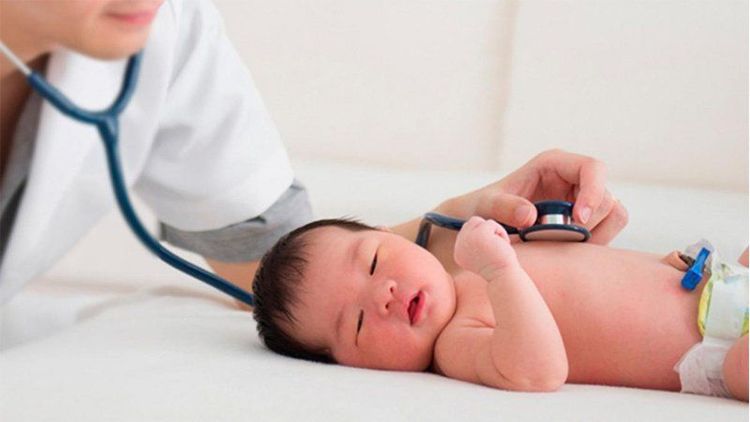
Bệnh lõm xương ức ở trẻ em có thể là bệnh lý có tính chất di truyền
3. Symptoms of Sternal Sternal Disease in Children The symptoms of Sternal Sternal Disease in Children depend on the severity of the condition and will vary from person to person. At a mild level the only symptom you may see is a small dimple in the chest. At a more severe level, the ribcage can deform and compress the heart and lungs causing symptoms such as:
Chest pain Palpitations Difficulty breathing after exercise or difficulty breathing depending on a position (namely bending over can make it difficult to breathe) Prolonged fatigue Fainting or dizziness Rapid or irregular heartbeat Frequent colds, upper respiratory tract infections Dry cough Shortness of breath Wheezing Symptoms begin and worsen worsens with age.
In addition to the above symptoms, children may also be psychologically affected because of chest concave symptoms and a number of diseases affecting their appearance as mentioned above, making them look different from their peers. they become depressed, get angry easily and have problems with their self-image, avoid communication, hesitate to act.
4. Classification of Sternal Concave Disease There are 2 ways of classifying Sternal Concave disease:
4.1 Classification by Degree of Concave Place a ruler across the rib cage, measure the distance from the deepest point to the ruler (A):
Concave mild: A ≤ 1 cm Moderate concave: 1.5cm ≤ A ≤ 2.5cm Severe concave: A ≥ 3cm 4.2 Classification according to concave type Chest concave concave: the depression is located in the center of the breastbone.
Eccentric chest concave: the depression is located to one side from the sternum.
Flat/narrow/flat thorax: the thoracic concave shape narrows anteroposteriorly.
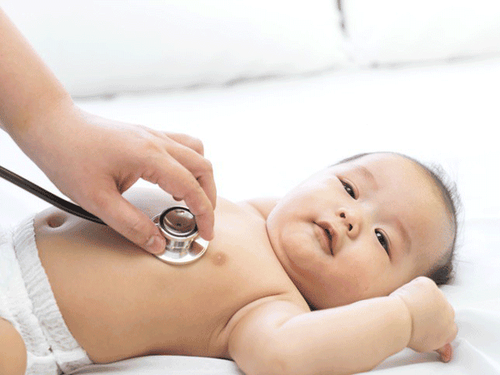
Chẩn đoán bệnh lõm xương ức ở trẻ em dựa trên triệu chứng thực thể, tiền sử bệnh
5. Diagnosis and treatment of sternal depression 5.1 Diagnosis Diagnosis of the disease is based on physical symptoms and medical history. If necessary, doctors can also order:
CT or MRI to assess the severity and degree of compression on the heart and lungs Echocardiogram, electrocardiogram to check heart function Pulmonary function measurement to check Pulmonary volume Stress testing 5.2 Indications for treatment Mild cases of sternal depression are not bothered by appearance and do not have breathing problems - usually no treatment is needed.
The overall goal of chest depression treatment is to improve airway, aesthetics, and cardiac function. Indications for treatment of sternal depression in children:
Haller index > 3.2. This index is measured on chest CT film. Cardiopulmonary symptoms already present Psychologically affected Aesthetic requirements 5.3 Treatments for breast concavity in children: 5.3.1 Nuss surgery Surgery for sternum indentation is called Nuss surgery. Nuss surgery to treat sternal depression is widely used around the world. This surgery is less invasive, with very little blood loss, thereby shortening the recovery time for the patient.
After making two short incisions on both sides of the thorax, about 2-3 cm, insert a metal support rod to the place where the sternum is concave and raise it to a predetermined position under endoscopic guidance.
The patient can resume normal activities after 1 month, but still need to avoid vigorous sports for the first 3-6 months. The bars are left in place for 2-3 years before being removed.
Surgery is usually done when children are 6-18 years old.
Complications after the Nuss procedure: postoperative pain may persist for 3 days, then subside and return to normal after 2 months. However, there may also be risks of the following complications: wound infection, pneumothorax, hemoptysis, allergy of the support rod, perforation of the heart and lungs.
5.3.2 Vacuum bell therapy In addition, recently in our country, we have also started to implement a surgical adjuvant therapy, non-invasive treatment of breastbone depression called vacuum bell therapy
In young children For more and for those who do not want surgery, the Vacuum Bell device can be used to correct the shape of the breasts. This is a rubber device in the shape of a bell, which is connected to a pump. The bell is placed on the chest, and the pump is used to draw the air out. This creates a strong pull to lift the depression of the sternum. The frequency of using the bell will increase over time and the level of response to the device: the first week every 30 minutes, 2 times / day. Week 2: 30 minutes each time, 4 times/day. Week 3: Use continuously while sleeping. Week 4: Use continuously for as long as possible.
Patients will be monitored and evaluated for functional and physical signs, indentation of the sternum after 1 week, 1 month and 3 months of treatment.
This therapy can be used as a complete alternative to Nuss implant surgery. In addition, the bell can also be used as a vacuum bell during the preparation for surgery, even during surgery to create a space behind the sternum, making the placement of the rod safer.
6. Preventing Sternal Sternum in Infants Sternal Sternal Disease in Newborns cannot be prevented in advance because doctors haven't figured out what causes it yet. But if you think your child has the condition, treatments are available that can help your child relieve severe symptoms.
Vinmec International General Hospital is one of the hospitals that not only ensures professional quality with a team of leading medical doctors, modern equipment and technology, but also stands out for its examination and consultation services. comprehensive and professional medical consultation and treatment; civilized, polite, safe and sterile medical examination and treatment space.
Please dial HOTLINE for more information or register for an appointment HERE. Download MyVinmec app to make appointments faster and to manage your bookings easily.




